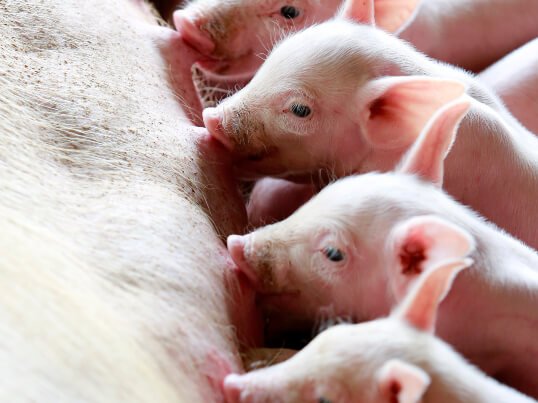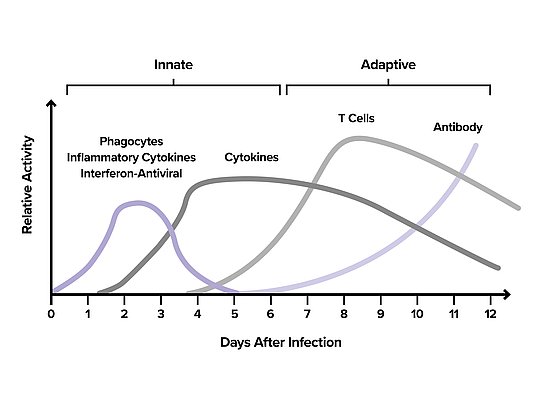The immune system in the spotlight: Phytogenic support for piglets
It´s an always current topic and on almost everyone's mind, not least because of the worldwide corona pandemic – that´s talk of the immune system: as precious as sophisticated.
Let’s have a look at this topic, which is also of great importance and interest in animal production. A well-functioning, balanced immune system prevents diseases and thus economic losses while improving animal welfare. Especially the weaning of young piglets poses a major challenge, in which the immune system plays an equally important role. For pig farmers it is the basis for a successful pig production to support their piglets in having a good start to life with optimal and consistent piglet weight at the end of the nursery period.
The immune system – precious protective shield

When talking about the body’s ability to respond to and defend against invasion of microorganisms, we talk about the immune system. It describes a highly complex and specialized system evolved to monitor, detect, respond to and eliminate any problem that appears to be harmful and could be identified as “foreign” to the body. This includes for example potentially pathogenic microorganisms, cancer cells or xenobiotics of any kind. After detection of a foreign presence, the immune system quickly starts to prepare countermeasures. To accomplish this task, every component of the immune system needs to perform on the highest level and according to plan. Neither an inadequate immune response nor an overreaction is advantageous. Hence, it is important to keep it in balance, rather than simply “strengthening” it.
The pillars of immune defense
a) Innate (non-specific) immune defense
Innate immune defense (including e.g., macrophages, granulocytes, etc.) is the part of the body's immune system present already in the embryo before birth. It offers a type of general protection including physical barriers like the skin and chemical barriers as well as specific proteins, immune cells and inflammation. The innate immune defense is initiated as soon as the body encounters anything recognized as foreign.
By the way, as part of the inflammatory response, fever contributes to the defense by reducing proliferation of pathogens while helping other parts of the immune system to work faster.
b) Adaptive (specific) immune defense
Adaptive immunity is the result of the immune system's active dealing with antigens throughout lifetime. The adaptive immune system learns by exposure to defined antigens to tailor a specific response. This occurs when the immune system is confronted with antigens, e.g., during infection or through vaccination. This process is characterized by a great capacity for adaptation and memory over lifetime, enabling the body to respond quickly to recurrence of familiar antigens.
c) Passive immune defense
Passive immunization is acquired when a baby receives maternal antibodies before birth or with mother´s milk, or by administration of antibody drugs. It is kind of "lent" from another source and only temporary.
Piglet´s immune system needs to develop

When starting with an embryo from conception until birth, it is mainly innate immunity, that is “active” in this period. This means that monocytes, macrophages, and natural killer cells start their work. Directly after birth, piglets receive colostrum milk from their mothers, which is very rich in antibodies to support the newborns immune defense. These immunoglobulins (IgG, IgA, and IgM) are essential for the passive immunity of the piglets. A race against time, as the milk composition of the sow milk starts changing (after about 15 hours). Therewith the concentration of important antibodies in the milk decreases and the piglet needs to establish its adaptive immune system to produce own antibodies. The most critical period during this development process is the time shortly before and around weaning with the so-called “window of susceptibility”. Consequently, the piglets are at higher risk of becoming ill during this period. So it is crucial to support them with phytogenic support for piglets.

As we are talking about the immune system as a defense system, let’s take a closer look at what happens after an infection of the body. Figure 1 shows us the activity of innate and adaptive immune defense in relation to days after infection in swine. In the first week (starting at day 0), it is the innate immune system, that sends the first “troops” against the invaders. Within two to three days, recruitment of phagocytes and production of proinflammatory cytokines rise but drop off again shortly afterwards (around day 5 of infection). This is when B - cells and T - cells start their work– the adaptive immune defense has taken up its job. All these processes are regulated by cytokines, which are small messenger proteins, produced by different kinds of immune cells. Obviously, a very exciting and precise interplay of all those “involved”, which is performed by the immune system.

What happens, if the immune system gets out of balance?

Elisabeth Rohrer
After her study in agriculture sciences at the university of natural resources and life sciences in Vienna, Elisabeth joined the Delacon team in December 2013 as Technical Communications Manager - a position, she always exerted with pleasure. Since 2021, her task areas have been extended and thus, she is also supporting colleagues in writing offside the technical focus as Content Manager. Elisabeth describes herself as a great animal and nature lover and prefers to spend her free time high up in the mountains with her little family, away from the hustle and bustle.











Very good articles the immune system in the spit light.